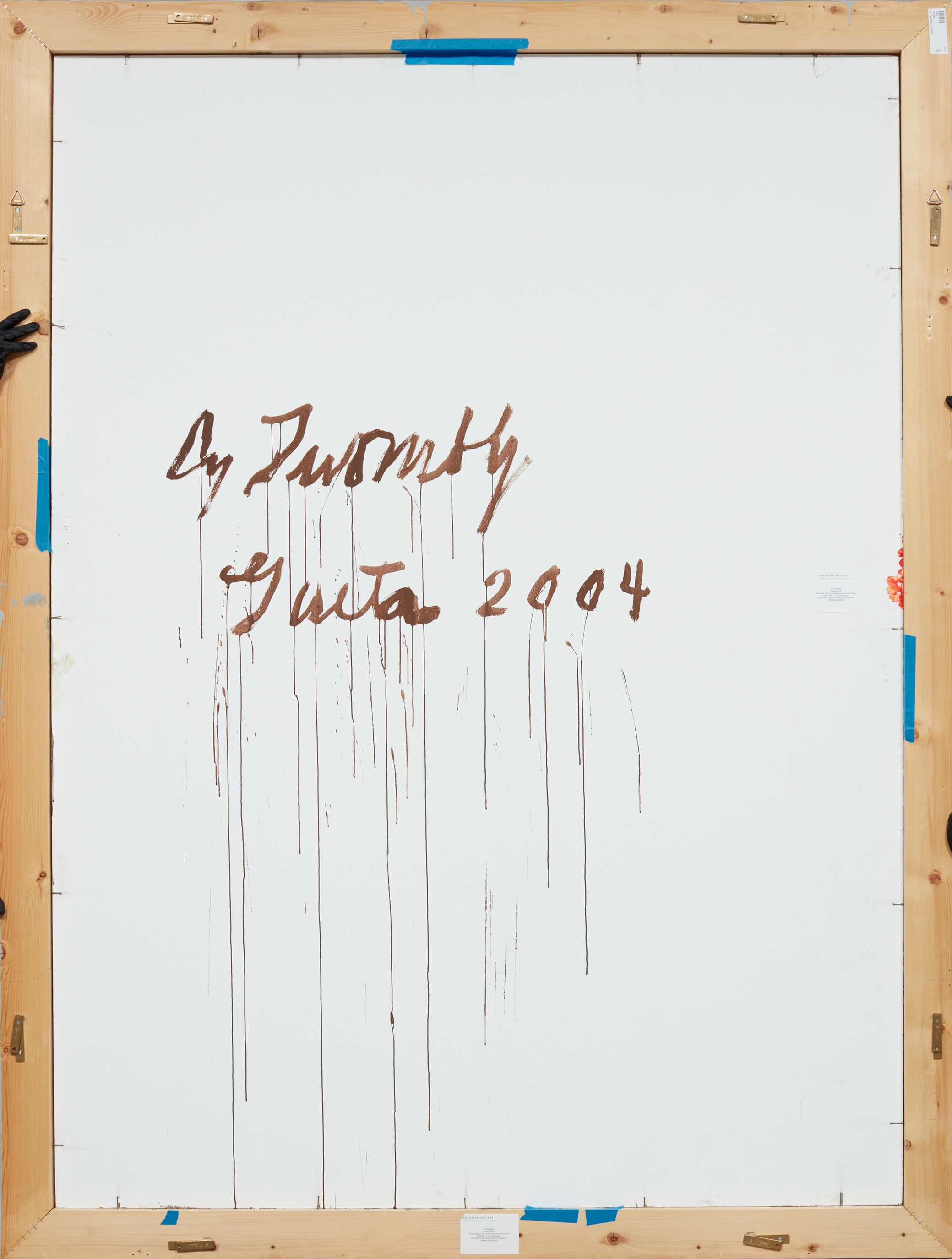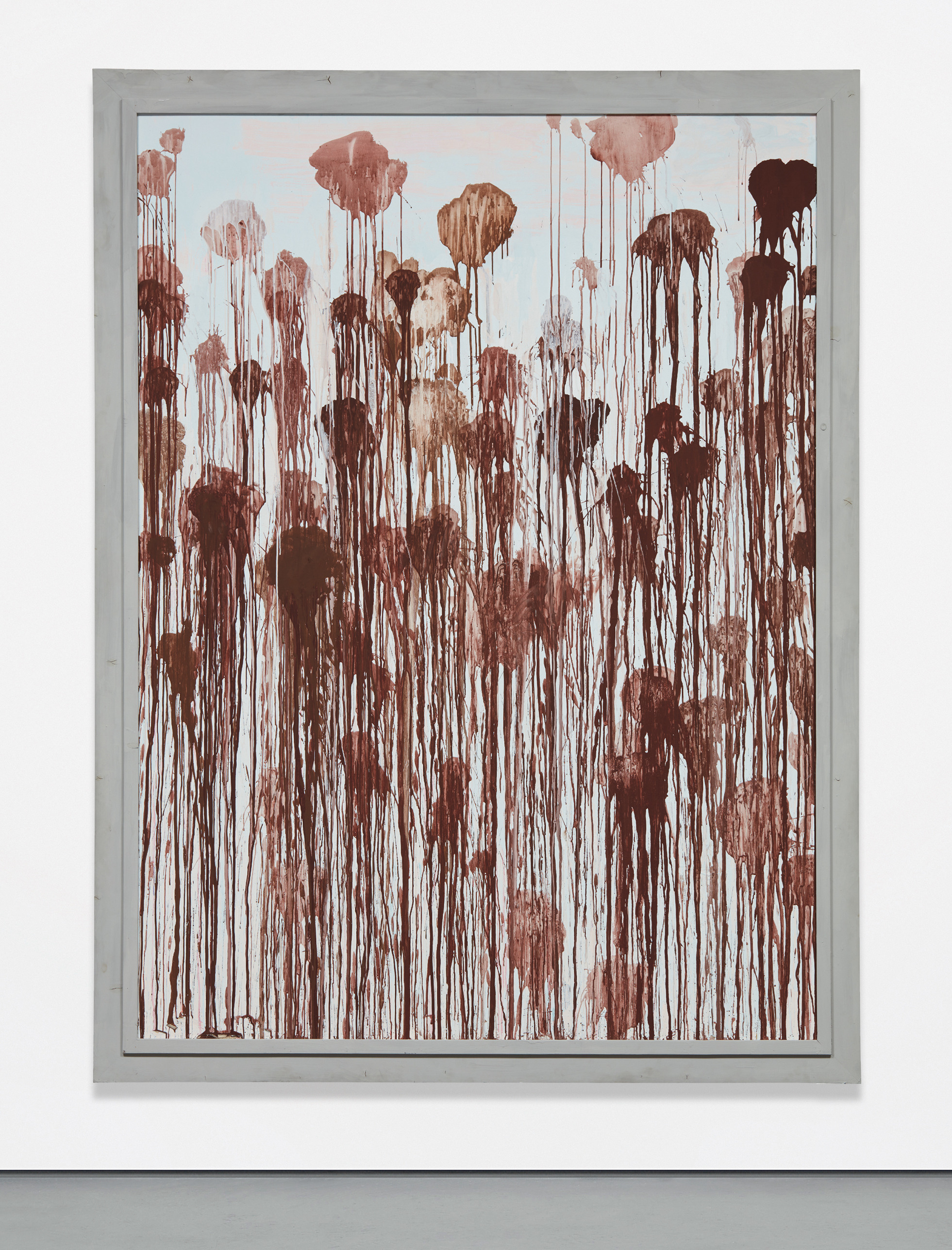





29
Cy Twombly
Untitled
frame 108 1/4 x 82 1/8 in.(275 x 208.5 cm.)
Full-Cataloguing
Executed in the final decade of Cy Twombly’s life, Untitled, 2004, is one of ten paintings that comprise the artist’s acclaimed Untitled (Winter Pictures) series. Coming full circle to his seminal series Poems to the Sea, which Twombly had created when he first became enchanted with the coastal landscape between Rome and Naples in 1959, Untitled (Winter Pictures) presents an epic painterly paean to the Mediterranean sea of his adopted home in Italy. Whereas Twombly had earlier in his career given up the brush for the pencil to intentionally suppress virtuosity, Untitled demonstrates how his technique evolved to exploit the loose gestures, broad daubs and spillage effects of paint. A remarkable example of Twombly’s inimitable painterly practice, Untitled is built up with coats of acrylic paint that the artist applied to the wooden panel with a combination of brush, cloth and hand. Having built up the ground with coats of quick-drying radiant white acrylic paint, Twombly activates the composition by repeatedly sweeping his drenched paintbrush down the length of the vast pictorial field. While all works from this series feature similar cascading vertical lines, Untitled is one of only two paintings distinguished by repeated circular blotches that run in splattering rivulets like dripping clouds beyond the edges of the pictorial support. While evocative of Twombly’s earlier blotches, the artist has here layered the forms through a process of gradated saturation that of thick and thinned torrents of earthy, reddish brown and white. Into this dense visual syntax Twombly introduces subtle flashes of yellow, light teal and red color, resulting in a sumptuous palimpsest that delights the senses.
Throughout Twombly’s inimitable oeuvre, site has been intrinsically linked to content. As Twombly stated, “Landscape is one of my favorite things in the world. Any kind of landscape stimulates me. I love the train ride from here [Rome] to Gaeta…I would’ve liked to have been Poussin, if I’d had a choice, in another time” (Cy Twombly, quoted in Cy Twombly, The Natural World, exh. cat., Art Institute of Chicago, Chicago, 2009, p. 19). Whereas Twombly’s earlier work was indebted to Greco-Roman historic conventions of landscape, Twombly in the last years of his life relied on plein-air observations or remembered sensations of nature – putting forward an atmospheric abstractions that offer an “enveloping effect, and contemplation in the vein of Turner and Monet” (Kirk Varnedoe, The Essential Cy Twombly, London, 2014, p. 75). Building on Twombly’s epic series Quattro Stagioni (A Painting in Four Parts), 1993-1994, Museum of Modern Art, New York, the series Untitled (Winter Pictures) points to Twombly’s serial preoccupation of this classical leitmotif, whereby the artist created the individual paintings simultaneously with the intention of later presenting them as a larger ensemble. “The subject of the seasons’ cycle is, of course, traditionally associated with quiescent or even melancholic retrospect,” Kirk Varnedoe pointed out, “but the grand scale and ambition of these canvases speak more forcefully of new confidence and freedom– savoring the pleasures and mournfulness of each part of the turning year” (Kirk Varnedoe, The Essential Cy Twombly, London, 2014, p. 77).
Whereas the preceding series A Gathering of Time, 2003, depicts the sensation of the turquoise waters Twombly encountered during his sojourn to the Caribbean, Untitled (Winter Pictures) presents the equanimity of the Tyrrhenian Sea as viewed from Twombly’s home in Gaeta. Twombly had established his light-filled, white-stuccoed residence in Gaeta in the 1980s, a few miles from the town of Sperlonga, where he had 40 years prior created Poems to the Sea, 1959. Twombly completed Untitled (Winter Pictures) over the course of six to eight months in the winter of 2003-2004, working in a breezeway room next to tall windows overlooking the full panorama of the Gulf of Gaeta. Standing in front of the towering Untitled offers the viewer a similar experience to viewing the vastness of the sea from Twombly’s studio as the wooden panels are, in fact, scaled to same proportion of the studio’s vast windows. As James Rondeau has observed, “Considered in this light, one can imagine the paint drippings as a depiction of rain washing over muddy panes of glass. Pondered as view of the sea, Twombly’s squiggles of brown paint suggest imaginative abbreviations of marine rhythms – the rims of waves or the motion of tides” (James Rondeau, Cy Twombly, The Natural World, exh. cat., Art Institute of Chicago, 2009, p. 26).
As with Twombly’s greatest works, Untitled beautifully engulfs the viewer with a certain, indefinable “kind of feeling” (Cy Twombly, quoted in Nicholas Serota, Cy Twombly: Cycles and Seasons, exh. cat., Tate, London, 2008, p. 51). Rather than presenting a literal depiction of the seascape, Twombly evokes the equanimity of the sea and remembrance of stillness as seen from afar during the cold winter months by exploiting the full atmospheric effects of color. The thin tendrils of teal color and white that emerge amid the somber earth tones suggest the hazy vastness Twombly encountered as mist or fog diffused his view of the sea. Applied in thin semi-transparent layers reminiscent of the brown or reddish “imprimatura” that Classicists such as Poussin used, the earthy, reddish browns at first glance may appear as a surprising color choice for rendering the seascape, yet are in fact reflective of a life-time of observing the changing hues of the sea. As Twombly indeed once reflected with regards to Poems on the Sea, 1959, “The sea is white three quarters of the time…The Mediterranean at least – the Atlantic is brown – is always just white…” (Cy Twombly, quoted in James Rondeau, Cy Twombly, The Natural World, exh. cat., Art Institute of Chicago, Chicago, 2009, p. 36).
Both originating from and extending Twombly’s direct observation of nature, Untitled becomes a more fundamental dismantling of the promises of transcendence inherent to the grand tradition of landscape painting. As such, it presents a powerful continuation of Twombly’s career-long interrogation of the limits of language, and by extension, meaning. It is the same “linguistic thing” that permeated through Twombly’s great drawings and paintings of the 1950s that appear in Untitled (Winter Pictures) in the meandering lines that the artist described as “kind of garbled form of Japanese writing…pseudo-writing” (Cy Twombly, quoted in Nicholas Serota, Cy Twombly: Cycles and Seasons, exh. cat., Tate, London, 2008, p. 53). As Kirk Varnedeo so poetically observed of the series , “The sea, a vacant mirror: this pale blue, white winter sea transforms reflections and ciphers from natural phenomena into poetic signs…in these paintings reveals writing and inversion, the sign and its expiration, like visual conundrums” (Kirk Varnedoe, Cy Twombly Catalogue Raisonné of the Paintings, Volume V, Munich, 2009, pp. 44-45). Seen in this light, the diffused white ground in Untitled functions in a similar way as in Twombly’s earliest works in its invocation of French Symbolist poet Stéphane Mallarmé’s concept of the white page as the precondition for textual meaning. This disavowal of the notion that text emanates from authorial intention proved influential for structuralist and post-structuralist deconstructions of the signifier-signified binary. Specifically recalling Mallarmé’s groundbreaking poem Un Coup de Dés Jamais N'Abolira Le Hasard, 1897, with its allusion to a seascape, Untitled inverts the claims to totality associated with the sublime landscapes in the canon of art history. As James Rondeau has identified, “Neither landscape nor language is…a truly natural phenomenon; both depend upon culturally inflected concepts or constructs, artifices simultaneously reveal and obscured by acts of drawing and painting. This is the heart of Twombly’s enterprise; he is able to operate within the genre in ways that concomitantly sanction and catechize its conventional effects” (James Rondeau, Cy Twombly: The Natural World, exh. cat., Art Institute of Chicago, Chicago, 2009, p. 19). Testament to an artist both building on and relentlessly pushing his conceptual and pictorial vocabulary, Untitled powerfully figures as one of Twombly’s great painterly triumphs in the very last years of his long life.
Cy Twombly
American | B. 1928 D. 2011Cy Twombly emerged in the mid-1950s alongside New York artists Jasper Johns and Robert Rauschenberg. While at first developing a graffiti-like style influenced by Abstract Expressionist automatism–having notably studied under Franz Kline and Robert Motherwell at the legendary Black Mountain College between 1951 and 1952–Twombly was a prominent figure in the new generation of artists that challenged the abstract orthodoxy of the New York School. Twombly developed a highly unique pictorial language that found its purest expression upon his life-defining move to Rome in 1957. Simultaneously invoking classical history, poetry, mythology and his own contemporary lived experience, Twombly's visual idiom is distinguished by a remarkable vocabulary of signs and marks and the fusion of word and text.
Cy Twombly produced graffiti-like paintings that were inspired by the work of Willem de Kooning, Jackson Pollock and Robert Motherwell. His gestural forms of lines, drips and splattering were at first not well-received, but the artist later became known as the leader of the estrangement from the Abstract Expressionism movement. Full of energy and rawness, Twombly's pieces are reminiscent of childhood sketches and reveal his inspiration from mythology and poetry.